
Google Ads: Better Audience Segments with Factors.ai
With a market share of 83% and its brand name officially a verb in the dictionary, it's no secret that Google is the most dominant search engine on the planet. This, in turn, makes search ads or PPC one of the most popular marketing channels for marketers as well. In fact, as much as 65% of SME businesses run PPC search ad campaigns on Google — with nearly 80% of teams claiming it's a necessity for success.

That being said, Google ad campaigns are not without their drawbacks, especially for B2B marketers. Google ads primarily rely on keywords and searcher intent in deciding when and where to display ads. Account-based marketers, however, would rather have a say in who to display their ads too as well.
For example, rather than blowing through budgets by displaying ads to everyone that looks up “CRM software”, an ABM marketer may prefer showing their ads only to a list of 1,000 specific target accounts. This way, wasted spends may be eliminated and bids may be raised, given the narrow target audiences. As it stands, however, Google supports a rudimentary and largely ineffective approach to audience building and segmentation for its ads. The following blog explores these limitations and highlights a better way to build audience segments with Factors.ai.
Let’s dive in.
As it stands: Google Ads audience targeting
Google Ads supports the ability to to reach people based on who they are, their interests and habits, what they’re actively researching, or how they've interacted with your business via Audience Segments.
How Audience Segments works
Google’s audiences are made up of segments of people with specific interests, intents, and demographic information based on Google’s database. Advertisers may choose from a wide range of segments such as “music fans”, “people shopping for bicycles”, or “people that have visited your website”. This data is estimated based on people’s engagement with Google’s own products and third-party websites. Specifically to Search ads, Google supports 4 types of Audience Segments:
- Affinity segments: Reach users based on their passions, habits, and interests
- Detailed demographics: Reach users based on long-term life facts.
- In-market: Reach users based on their recent purchase intent
- Your data: Reach users that have interacted with your business.some text
- Website and app visitors: Reach people who have visited either your website or apps.
- Customer Match: Reach your existing customers based on your CRM data.
- Similar segments: Reach new users with similar interests to your website visitors or existing customers.
In addition to this, Google also supports Custom Segments and Life Events as segment types for it’s other ad channels (Display, Videos, etc).
Limitations with Audience Segments
In theory, Audience Segments sound super valuable. Based on your selection of Audience segments, Google’s AI models will automatically choose the right audience to best fit the needs of your campaign. However, a closer inspection reveals inherent limitations with each of the four approaches:
- Affinity segments, detailed demographics and in-market segments are primarily tailored for B2C and D2C use-cases. That is, they’re built to cater to audiences based on individual interests, as opposed to account-level buying intent. They may work well to identify and target “skiing enthusiasts”, these audience segments often struggle with “B2B SaaS teams looking for a CRM”.
- Your data audiences segments do a slightly better job in that they attempt to target audiences based on existing brand engagement. Still, it’s fraught with limitations. According to Google’s advertising policy, Google advertisers may only upload customer data, not prospecting data from their CRM. This is of course, extremely limiting given that the majority of your total addressable market may not be actively engaging with your brand. Furthermore, Google’s own retargeting capabilities are limited to a vague set of website visitors (via Google Analytics) as opposed to comprehensively enriched audiences across website traffic, LinkedIn ads, and other channels.
That being said, if you provide Google enough data about your target audience members via Customer Match lists, it can spot your target accounts and serve them, and them alone, your ads.


Long story short, Google’s native targeting mechanisms exist by the name of Audience Segments. However, this isn't, in its current form, very helpful to B2B marketers. In the following section let’s explore how Audience Segments may be used as a jumping off point in tandem with an account intelligence and activation tool such as Factors.ai to make the most of your targeted ads.
Better Google audiences & targeting with Factors.ai
What if you could retarget existing customers with personalized ads on upselling opportunities? Or vary your bids based on buying stage and ICP fitment? Or re-engage with long gone MQLs and lost opportunities with YouTube ads or GDN? These are a few examples of the powerful use-cases supported by Factors.ai for your Google Ads. Here’s how it works:
- Identify and enrich: Factors identifies and enriches anonymous companies engaging with your website, LinkedIn ads, and G2 pages. These companies may be segmented via a combination of granular engagement and firmographic criteria within Factors. These segments may be as straightforward or involved as you’d like. A straightforward segment may look like: “US-based software companies” while involved segments may look like: “US-based software companies with 100-999 employees that have viewed at least one LinkedIn ad and visited the pricing page”. Create as many segments as you’d like depending on your intended objectives and granularity.
- Fire into Google Analytics: The next step involves firing relevant events (in this case, an event is an engaged company that matches your segment criteria) into Google Analytics. As you might recall, Google Ads will only retarget website visitors and contacts that have been recorded in GA or your CRM. Pushing these audience segments from Factors into GA acts as proxy to this.
- Push from GA into Google Ads: Now that you have built up segments in Google Analytics, it’s a simple matter to push said accounts into Google Ads for further targeting across search ads, videos ads, display ads, and more. Here are a few more ways in which you can use this flow:

How you can use Factors.ai + Google Ads
In addition to the aforementioned use-cases, here are a few more ways to leverage Factors.ai:
Variable RSA
Regardless of the size of your business, your marketing team is working with a budget. Accordingly, most marketers focus their efforts on specific, relatively low-volume keywords so as to not blow their budgets on irrelevant clicks from high-volume keywords. With Factors, however, you can have the best of both worlds by bidding on broader keywords and response search ads only for the companies you care about. For example, you may bid $2 for the long tail keyword “CRM software for US-based SMEs” but bid $6 for the short tail keyword “CRM software” only for the Audience Segment you care about. This way, the higher bid ads will be displayed only when your target accounts are searching for it — as opposed to the entire internet.
Granular targeting
Given marketing’s limited budgets, you could choose to focus your ad spend only on companies that meet a super specific engagement and ICP criteria as the one highlighted earlier (“US-based software companies with 100-999 employees that have viewed at least one LinkedIn ad and visited the pricing page”). This way, you know that your ads will be served only to highly engaged accounts with explicit buying intent. This smaller pool of target accounts also enables you to raise bids more aggressively given the focused scope of audiences.
{{CTA_BANNER}}
Cross-channel targeting
A key aspect of the account-based market is targeting (and retargeting) accounts across channels. At the moment, Google Ads only supports the ability to target accounts visiting your website or in your CRM. With Factors, this reach may be expanded to companies viewing your LinkedIn ads, engaging with your G2 pages, or simply part of your ABM target accounts list. These segmented accounts may then be automatically targeted across your search ads, display ads, videos ads, LinkedIn ads, mail outreach, and more with Factors’ code-free workflow automations.

Google Ads' native audience segmentation offers basic targeting options like affinity, in-market, and demographic segments. However, these can be limiting for B2B marketers aiming for precision.
Here's how Factors enhances Google Ads targeting:
1. Custom Audience Segments: Factors.ai enables the creation of custom audience segments based on firmographic data, buyer intent signals, and CRM insights.
2. Benefits: This approach allows for more effective targeting of high-intent accounts, reducing ad spend waste and improving ROI.
3. Advanced Segmentation: Integrating Factors.ai with Google Ads facilitates advanced audience segmentation, aligning marketing efforts more closely with sales objectives and enhancing overall campaign performance.
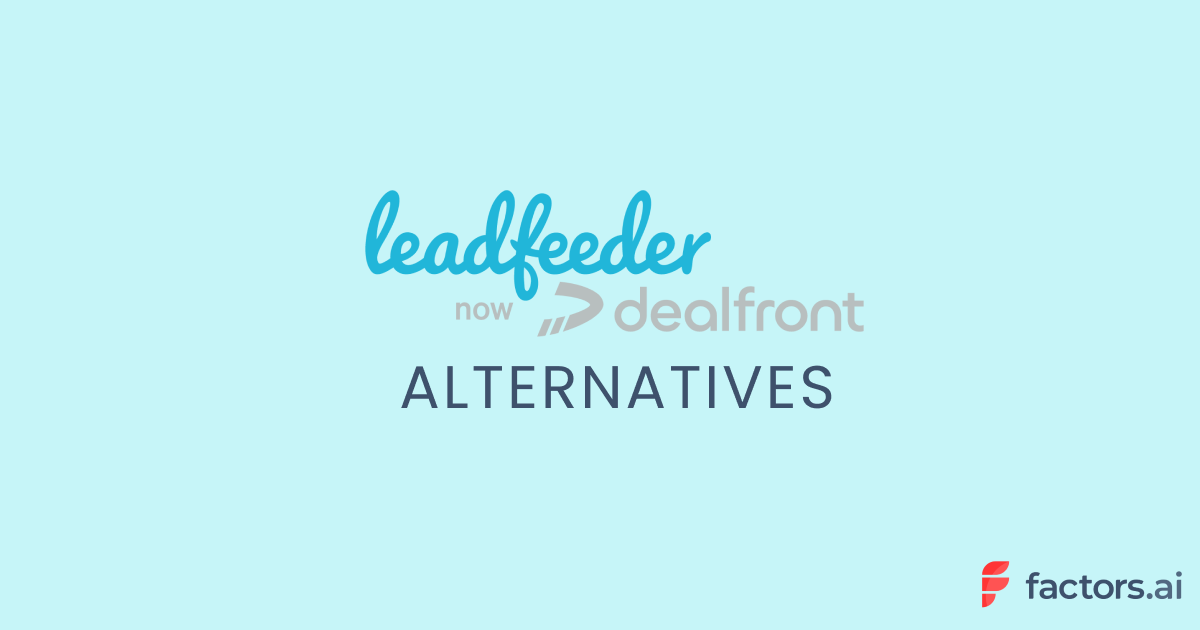
Best Leadfeeder Alternatives For Website Visitor Identification
It’s official. Leadfeeder has joined forces with Echobot to form Dealfront — a Europe-centric go-to-market platform. As a result of this merger, Leadfeeder’s pricing plans have increased to start at $215+ per month with limited seats and data.
Several Leadfeeder users are looking for comparable sales intelligence alternatives to help identify and track anonymous website visitors.
If you’re in the same boat, or are simply considering your options, this is the right place for you.
The following article explores 5 comprehensive Leadfeeder alternatives to help your team make a seamless switch. We'll highlight key features, benefits, and drawbacks with each Leadfeeder alternative.
By the end of this article, we’d like to help you find an equally effective, if not better, alternative to your current visitor identification tool.
Looking to learn more about visitor identification? Check out these further readings:
Leadfeeder Alternatives For Website Visitor Identification
1. Factors.ai
Leading off our list is Factors.ai. Factors is unique in that it’s originally built upon strong analytics and attribution foundations. A recent partnership with 6sense, a leading enterprise-grade ABM platform, has propelled Factors into becoming a rising star in the visitor identification software space.
With this collaboration, Factors delivers industry-leading visitor identification, firmographics, and account timelines along with its existing ABM analytics and multi-touch attribution capabilities.
Factors.ai Key Features
Here’s a brief breakdown of Factors.ai’s key features
1. Account Identification
Of course, every tool featured on a list of Leadfeeder alternatives must be capable of identifying and tracking accounts visiting the website. Factors is no exception to this. In fact, as a result of its collaboration with 6sense, Factors taps into enterprise-grade IP data to identify up to 64% of anonymous companies — including firmographics (employee headcount, industry, location, etc) and website activity (page visits, time spent, scroll-depth, etc).
Factors also provides real-time Slack alerts to help teams stay on top of high-intent visitors and strike while the iron’s still hot. These alerts can be configured to go off based on specific firmographic features and website behavior — so you can target ICP companies visiting your site.
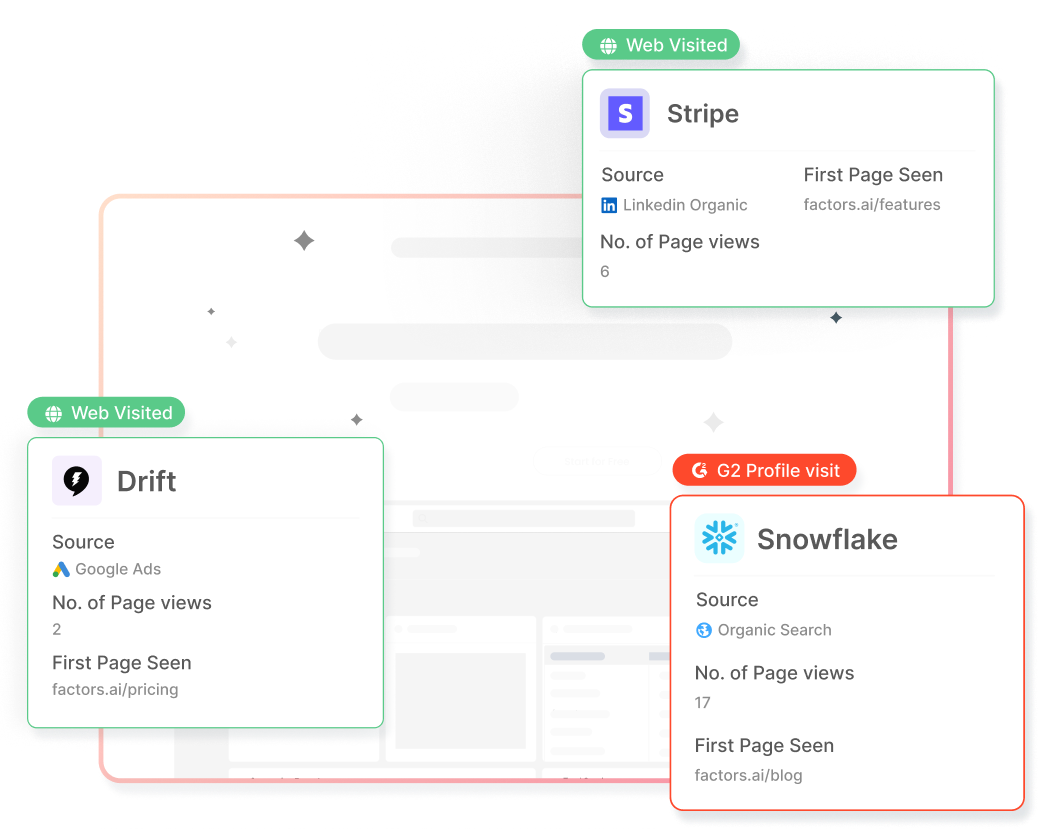
2. Account Scoring & Timelines
Factors integrates with campaigns, website, and CRM data to provide cross-channel account scoring and full-funnel timelines across the customer journey. With this feature, users can see exactly what touchpoints (ads, blogs, emails, webpages, etc) are influencing accounts to progress from top-of-the-funnel visitors to paying customers. Users can identify and prioritize high-intent accounts for focused outreach and re-marketing efforts
3. Advanced Analytics:
Unlike other solutions on this list (including Leadfeeder), Factors provides a wide range of analytics and attribution capabilities in addition to visitor identification. A few advanced analytics features include:
- ABM analytics - Integrates with ad platforms, CRMs, CDPs and more to unify reporting and support campaign analytics, website analytics, funnels, and more at an account level.
- Path analysis - View aggregate user behavior and identify points of inflection in conversions and drop-offs along the customer journey
- Multi-touch attribution - Connect the dots between go-to-market initiatives and pipeline, optimize resource allocations across campaigns, and prove marketing ROI with a wide range of multi-touch attribution models.
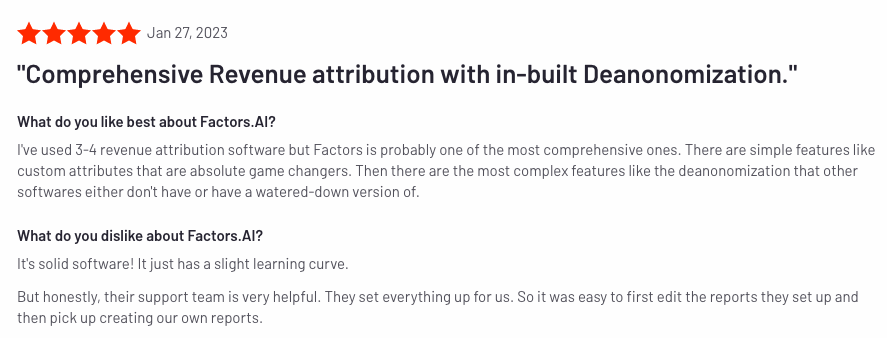
{{INLINE_CTA_A}}
Benefits of Factors.ai
Here are a few reasons why you may prefer Factors.ai to other tools:
1. Data accuracy: As previously mentioned, Factors taps into 6sense’s extensive database to provide industry-leading website visitor identification. In fact, rigorous testing with a sample data set of over 20,000 domains reveals that Factors identifies upto 27% more accounts than the closest alternatives — including established brands such as Clearbit and Demandbase.
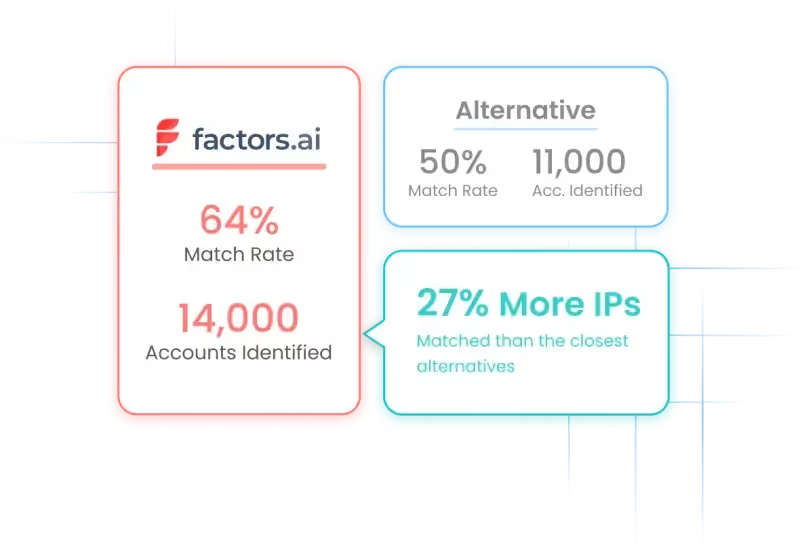
2. Granular metrics: Given Factors’ roots in account analytics, it’s capable of reporting granular metrics and events as compared to other visitor identification alternatives. A few of these include:
- % scroll-depth
- Auto-button captures
- Cursor engagement
- Page time spent
3. Scoring & Alerts: Not all your website visitors are immediately read-to-buy. Some are further along the funnel than others. According, Factors supports custom account scoring models so you can qualify and be alerted to high-intent, ICP accounts engaging with your company in real-time.
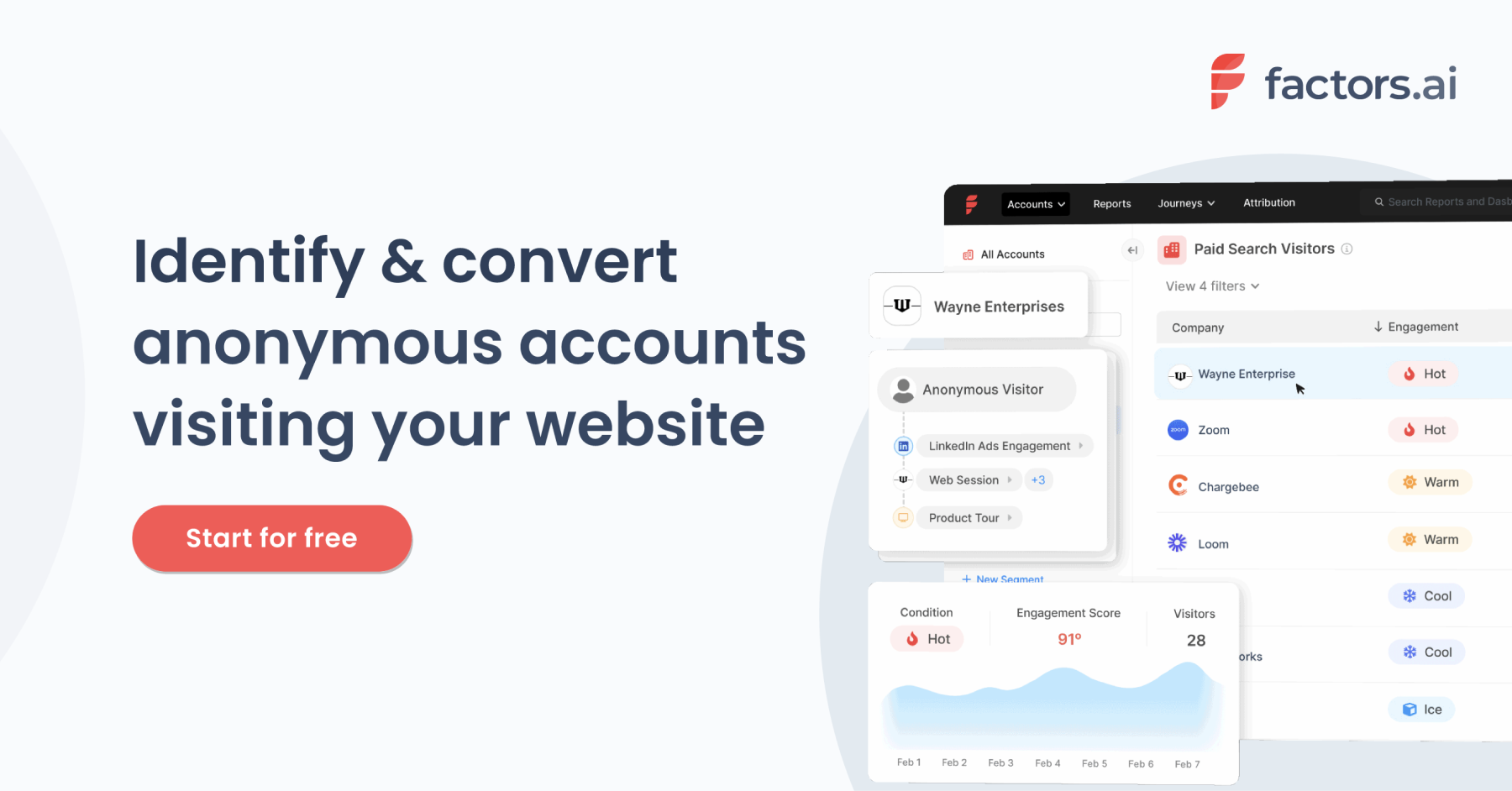
Drawbacks of Factors.ai
Contact-level enrichment - No privacy-compliant software can identify exactly which individual visited a website without having a visitor explicitly submit a contact form. That being said, the majority of tools on this list can source a list of ideal prospects to reach out to from the companies they’ve identified.
At the moment, Factors cannot provide this information natively. Instead, users can find contact information on third party tools such as Zoominfo or Apollo.
Factors.ai Pricing
Learn more about pricing here: factors.ai/pricing
Curious to see Factors in action? Book a personalized demo here.
{{INLINE_CTA_A}}
2. Albacross
Next up, we have Albracross. Albracross is one of the leading visitor identification and intent data companies in Europe. The Sweden-based platform works with over 10,000 companies to provide customer data enrichment, sales alerts, and intent signals.
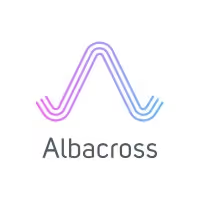
Key Features
1. Account Identification: Like the other tools on this list, Albacross identifies anonymous accounts, firmographic information and visitor intent. Albacross features one of the largest proprietary first-party databases in the world.
2. Personalization: Albacross natively integrates with popular personalization tools such as Optimizely and VWO to customize website content based on who’s visiting the site. This is a powerful feature for product marketers looking to identify visitors and tailor messaging based on their profiles.
3. Display ads: A nifty feature offered by Albacross is the ability to launch and monitor display ads within the platform itself. The software partners with several publicists such as The New York Times and Daily Mail to distribute account-level targeted ads.
Benefits of Albacross
Here are a few reasons why you may prefer Albacross to other tools:
1. Experimenting: Given that Albacross is one of the few Leadfeeder alternatives to integrate with personalization tools, it offers the unique benefit for product marketers to experiment and run A/B tests in conjunction with visitor identification and intent data.
2. Customer success: Several reviews rave about Albacross’s stellar customer success management. Given that Albacross is considered to be an involved, enterprise-level tool, it’s essential to have this level of support to get the most value out of the product.

Drawbacks of Albacross:
Here are a few reasons you may consider other tools over Albacross:
1. Rigid firmographics and filters - Albacross seems to lack agility when it comes to filters and breakdowns. Reviews reveal that it’s currently not possible to filter identified companies based on firmographics such as name or size. As a result, users seem to find sorting and reporting somewhat challenging.

2. Buggy integrations: Multiple reviews claim that Albacross’s integrations, especially with CRMs like Salesforce, could do with some work. Given that visitor identification is primarily used to support ABM, this can be a major drawback to B2B teams. Tools like Zapier may be used to smoothen out workflows for now.

3. Lead Forensics
Founded in 2009, Lead Forensics is the oldest, most established website visitor identification software in this list. They own a sizable database of over 1.4 billion IP addresses, adding up to 55 millions contacts every year.

Key Features
Lead Forensics doesn’t have too many bells and whistles as compared to the other tools on this list. Its primary features are limited to visitor identification and contact data.
1. Account identification: Like Leadfeeder, Factors, and Albacross, Lead Forensics identifies anonymous businesses visiting your website by connecting the dots between IP addresses and company names. In the case of multinational companies, Lead Forensics is capable of showing which specific office is interacting with your website. This is handy for businesses looking to sell to large corporations.
2. Contact data: Lead Forensics also helps teams identify key contacts within companies visiting your website to assist with retargeting and outbound reachout. Here’s a brief summary of the kind of details that Lead Forensics can provide:
- Business name
- Contact details of key decision makers
- Telephone, email and LinkedIn details
- Demographics
- Search behavior
- Financial data

Benefits of Lead Forensics
A unique benefit with Lead Forensics is its mobile application. With their “Essential” plan, users can have trigger reports sent directly to their phones.
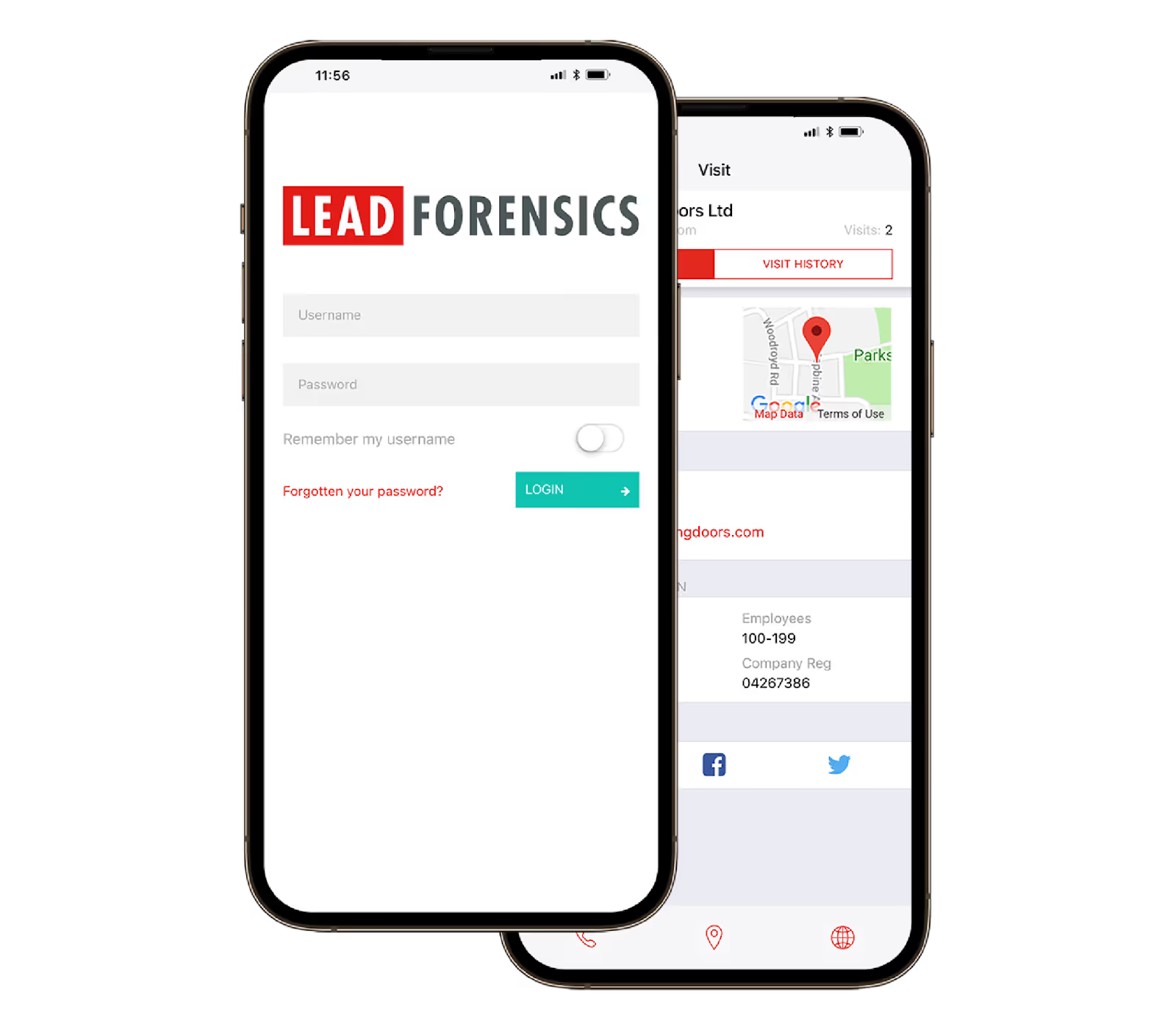
Drawbacks of Lead Forensics
Here are a few reasons you may consider other tools over Lead Forensics:
1. Poor UI - Lead Forensics is one of the oldest visitor identification software around. While experience is generally a positive sign, several users complain about Lead Forensics’ UI remaining outdated and unintuitive. Users find the tool to have limited functionality in terms of ad-hoc analysis, dashboards, and filters as well.
2. Pricing - While Lead Forensics does not openly reveal its pricing plans, it’s generally considered to be on the more expensive side. While this may not be a barrier for larger, enterprise-level companies, pricing may be prohibitive for small to mid-market start ups — especially when there are cost-effective alternatives available.

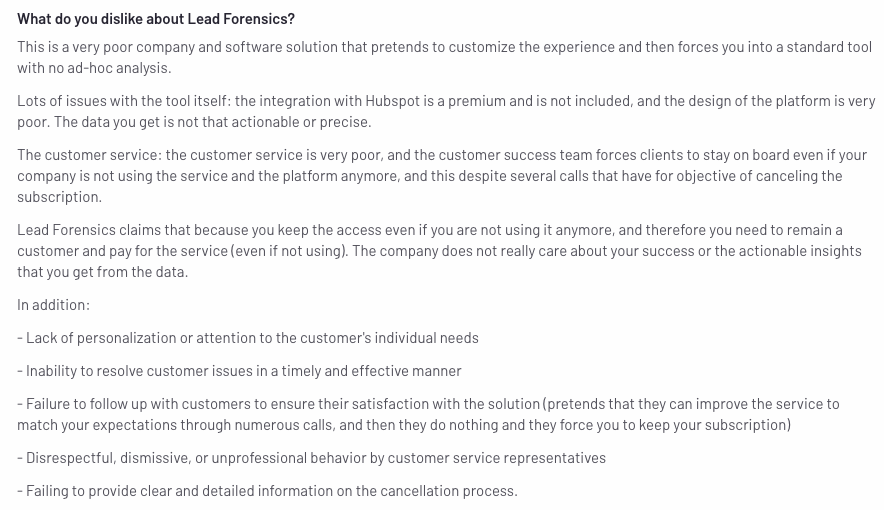
{{INLINE_CTA_A}}
4. Clearbit
Fourth in our list is Clearbit. Clearbit is another well-established B2B data activation platform that offers a wide suite of products within its platform.

Key Features
Clearbit is divided into three broad products:
1. Reveal - Clearbit identifies anonymous website visitors using IP-lookup. Given that every tool on this list does this, data accuracy and pricing are two important considerations when differentiating between alternatives.
2. Enrichment - Clearbit also provides firmographics from over 250 data sources. This includes technologies, headcount, revenue, location, contact information, and more.
3. Capture - like Leadfeeder Contacts, identifies best-fit contacts from companies visiting your website to reach out to with retargeting campaigns or outbound efforts

Benefits of Clearbit
1. Free plan: While Clearbit’s paid plans are relatively expensive, they offer a nifty free plan to de-anonymize anonymous traffic. That being said, the free plan is quite limiting as users can enrich only 50 domains a month. This becomes an issue as website traffic starts to scale over time. Still, it’s free — so who can complain?
Here’s a breakdown of what Clearbit’s free plan offers:
- Identify site traffic
- Calculate total addressable market size
- Determine ideal client profile
- Enrich domains and emails (up to 50 per month)
- Find email addresses (up to 100 per month)
2. Smart chat: Smart chat is a handy feature for sales reps to connect with high-value, high-intent visitors with personalized conversational ABM while visitors are live on the site. Chat prompts can be triggered based on visitor characteristics and behavior such as industry, page views, headcount, etc.
Drawbacks of Clearbit
1. Pricing: Clearbit does not reveal pricing details on its website. But several user reviews suggest that pricing is on the higher side for early to mid-stage startups.

2. Customer support: Clearbit works with a wide range of clients from early-stage startups to enterprise-level companies. Users from the former seem to face issues when it comes to customer support, claiming that it’s often slow and inadequate.

5. Visitor Queue
The final option on our list is Visitor Queue. Visitor Queue is a Canada-based visitor identification and personalization platform that identifies the name, contact detail and user data of accounts visiting your website.

Key Features
1. Visitor identification: What separates Visitor Queue from the rest of the tools on this list is its ability to aggregate company social profiles in addition to standard firmographics and contact information.
2. Personalization: Like Albracross, Visitor Queue allows users to personalize their website based on configurable criterias such as industry, source/medium, location, and more. This helps product marketers differentiate their brand from competitors and experiment with different messaging to improve conversions.
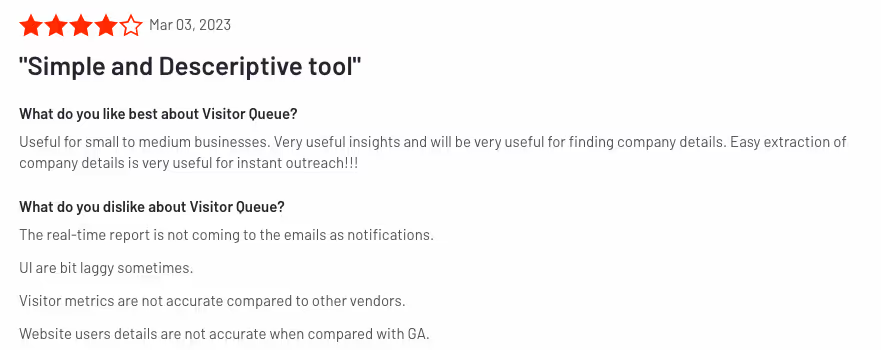
Benefits of Visitor Queue
1. Unlimited users - Most tools on this list (excluding Factors.ai) limit the number of seats per account. Given that visitor identification is used by sales, marketing, and customer success teams, it’s valuable to have an unlimited number of users with Visitor Queue.
2. Pricing - Visitor Queue is a more affordable option as compared to the likes of Clearbit and Lead Forensics with prices starting at just $31/month to identify 100 companies per month. This makes it a good option for early-stage teams that are working with tight budgets.
Drawbacks of Visitor Queue
1. Rigid reporting - While Visitor Queue does well at the basics, users complain about its restrictive UI when it comes to ad hoc reports, filters, and dashboards. As a company starts to grow, its requirements for tailor-made reporting do too. Visitor Queue wouldn’t back a good fit for custom usage.

2. Data issues - User reviews complain about data inaccuracies with Visitor Queue. While no tool is perfect, Visitor Queue seems to lag behind industry-standards in terms of accurately identifying visitors. While it’s great to have an inexpensive alternative, a visitor identification tool won’t be of much value unless it identifies the right visitors.

And there you have it! A brief summary of 5 comprehensive Leadfeeder alternatives to help you identify anonymous website visitors. Each of these tools have their pros and cons — and one is likely to be better suited to your needs than the others.
Top Leadfeeder Alternatives
Businesses seeking cost-effective and feature-rich website visitor identification tools can explore various alternatives.
1. Leading Alternatives: Factors.ai for advanced analytics and attribution, Visitor Queue for affordability and effective lead tracking.
2. Key Features: Pricing flexibility, seamless integrations, high data accuracy, and real-time visitor insights.
3. Decision Factors: Evaluate based on budget, integration needs, and business-specific requirements.
Selecting the right platform enhances lead generation, improves marketing efficiency, and drives better conversion rates.
Let’s make the decision easier for you:
- If pricing and account-level data accuracy are priorities, Factors.ai is likely the best option.
- If the ability to personalize your website based on who’s visiting your site is what you’re looking for, Albacross and Visitor Queue are two great options.
- If you’re a larger enterprise without budget constraints, Clearbit could be the right option.
Factors.ai identifies up to 64% of anonymous visitors, the highest match rate in the industry. Looking to learn more about how Factors can help? Book a personalized demo here!
All in all, choosing the right Leadfeeder alternative depends on your priorities, whether that’s pricing, data accuracy, personalization, or advanced analytics. Tools like Factors.ai and HockeyStack offer robust analytics and attribution for GTM teams. Visitor Queue and Albacross cater to product marketers looking to personalize based on intent. Clearbit and Lead Forensics serve teams that require enriched contact data and ABM alignment. Evaluate your needs and test out a few platforms before you make the switch, the right visitor ID tool can make a tangible difference to your pipeline and outreach efficiency.
{{INLINE_CTA_A}}
.avif)
ZoomInfo Pricing, Alternatives & Overview - 2025 Guide (Updated)
ZoomInfo is an industry-leading B2B go-to-market platform that helps teams identify and connect with their target audience through account and contact-level data, but that’s not all. They are actively working on changing their position in the market from a data provider to an end-to-end market software company. Hence, it’s essential to understand the details of ZoomInfo’s latest offerings, prices, and updates. But that raises the question: how do ZoomInfo pricing plans work? What does ZoomInfo cost? And is ZoomInfo really worth it?
This article highlights everything you need to know about ZoomInfo, including ZoomInfo pricing, overview, alternatives, and more.
TL;DR
- ZoomInfo pricing is entirely quote-based, with annual costs ranging widely and commonly starting at $25,000 for small teams.
- Credits are central to its pricing model, with each search or contact reveal consuming varying amounts; additional credits cost extra.
- ZoomInfo Copilot adds AI capabilities, including real-time account insights, conversational queries, and automated outreach.
- Strong competitors like Apollo, Lead411, and Cognism offer viable alternatives with free tiers, transparent pricing, and solid feature sets.
ZoomInfo Overview: What is ZoomInfo?

ZoomInfo is an end-to-end go-to-market software company that is one of the most extensive contact and company-level intelligence databases for sales marketing use cases. ZoomInfo is divided into four broad products:
- SalesOS: Contact & company search, sales automation, conversation intelligence, workflows
- MarketingOS: Cross-channel advertising, buyer intent insights, website chat, form enrichment
- OperationsOS: Data cleansing, data enrichment, lead routing
- TalentOS: Talent search, candidate outreach, employer branding
SalesOS is the most popular product in the ZoomInfo lineup, and with good reason: ZoomInfo's impressive database spans 321 million active professionals at 104 million companies. This, in combination with its advanced search filters, real-time alerts, and integration capabilities, makes ZoomInfo an attractive platform for sales marketing teams. However, it is generally considered a premium product, often out of reach for smaller teams seeking cost-effective intelligence solutions.
ZoomInfo Pricing

ZoomInfo's pricing is complex and varies based on several factors. Pricing is not publicly disclosed and is offered through a custom, quote-based structure, making it necessary to engage directly with the company to estimate costs.
Key factors influencing ZoomInfo pricing include
- features,
- licenses,
- credit usage, and
- contract length and terms.
The number of features required, credit usage, and contract length significantly impact the overall cost.
Credits in ZoomInfo are consumed whenever an action is performed, such as viewing or exporting contact information—higher credit usage results in higher costs, requiring effective credit management to avoid unexpected expenses.
Comparing ZoomInfo pricing with competitors like SalesOS reveals a custom quote-based structure with an average annual expenditure of around $30,000. SalesOS offers more transparent pricing tiers with lower entry points, but higher-level plans can approach the costs of ZoomInfo's mid-tier offerings.
Use cases have shown that the high costs, sometimes upwards of $30,000 annually, are justified by significant ROI through improved lead generation, data enrichment, and overall sales performance.
How Much Does ZoomInfo Cost?
ZoomInfo's pricing is tailored to specific user requirements and usage, focusing on providing high-quality data and sales intelligence functionalities. Businesses should explore different pricing plans, utilize free trials, compare costs with alternatives, and use diverse data providers to optimize cost and performance in their sales intelligence efforts.
Our teams also spent a considerable amount of time talking to some existing ZoomInfo customers, and we found that the pricing was majorly based on:
- Seat-based minimum pricing
- Consumables or credits which can be bought on an ad-hoc basis
Some customers pay approximately $25,000 annually for about eight seats, while others pay $58,000 for about 21 to 23 seats. We also found that customers usually achieve a 50% discount after negotiations.
ZoomInfo Credits
ZoomInfo offers various pricing plans, each with a specific number of credits under each plan. If you need more credits, you can purchase them as needed. This credit-based system allows users to access particular contact and company information from its database for lead enrichment. Users can collect specific data with each credit, such as work email address, phone number, job title, etc. However, the credits required may vary depending on the type of information requested.
For example, basic contact details may consume fewer credits, while more comprehensive data, like technographic information, requires additional credits.
Limitations of ZoomInfo Credit-Based Model
1. Purchasing Credits Can Increase Costs
Each credit opens a set of specific information needed for lead enrichment. Once the credits are exhausted, users have to purchase additional credits. This can be expensive for certain companies with extensive data requirements or budget constraints.
2. Missed Opportunities
Limited credits may restrict the number of leads and opportunities a company can pursue. This affects growth, which is particularly challenging for expanding organizations or those in competitive markets.
3. Impact on Sales Engagement
Sales reps usually engage with multiple decision-makers and influencers within a target account. Each contact’s information requires additional credits, and sales reps might be unable to reach out to multiple people in the same organization. This restriction can limit the depth of engagement and reduce the chances of sales influencing the purchase decision.
New Launch: ZoomInfo Copilot
ZoomInfo has launched Copilot, an AI-powered solution designed to assist sales teams in closing deals more efficiently and effectively. Copilot leverages AI technology to provide valuable insights from ZoomInfo's B2B data, aiding sales professionals in making informed decisions and taking prompt actions. The platform aims to transform sales operations by enhancing productivity and accuracy in engaging with qualified leads at the right moment.
Key Features of ZoomInfo Copilot:
- Buying Groups: Copilot creates buying groups of individuals aligned with ideal customer profiles based on real-time signals from various sources like websites and case studies. This feature streamlines lead prioritization and ensures efficient engagement with prospects.
- Account Summaries: By aggregating first- and third-party data, Copilot provides detailed overviews of specific accounts, including pain points, upcoming deals, and key contacts. These summaries equip sales professionals with a comprehensive understanding of prospective customers, enhancing their preparation for interactions.
- Copilot Chat: This conversational AI system offers instant answers about specific accounts, enhancing the speed and accuracy of decision-making during customer interactions.
- AI Email Generator: This tool assists users in creating personalized and targeted emails at scale, optimizing the outreach process and saving time for sales professionals.
These features collectively empower users to work smarter, predict leads more accurately, streamline processes, and enhance customer engagement. ZoomInfo Copilot represents a significant advancement in sales technology, offering a comprehensive AI-driven solution to help businesses thrive in competitive markets.
Read more about Copilot from ZoomInfo’s CEO, Henry Schuck:
https://www.linkedin.com/pulse/future-gtm-ai-introducing-zoominfo-copilot-zoominfo-ef91c/
Why Do Businesses Use ZoomInfo?
ZoomInfo is one of the most popular B2B sales intelligence and GTM tools today — and with good reason. Albeit not without its limitations, ZoomInfo delivers certain unequivocal advantages over its competitors. Here’s why people use ZoomInfo over alternatives:
1. Robust North America sales intelligence data
With over 320 million business contacts and 100 million companies in its database, ZoomInfo provides one of the most comprehensive sales intelligence platforms today. This holds especially true for data on companies and professionals in North American geographies. Here’s how ZoomInfo’s volume of data breaks down as of Oct 2023:Rest of the World (Excluding North America):
- 104 million email addresses
- 45 million mobile numbers
- 27 million direct phone numbers
North America:
- 70 million email addresses
- 49 million mobile numbers
- 43 million direct phone numbers
Given that approximately half of ZoomInfo’s large data is North America-focused, this is a key plus point for GTM teams with primary audiences in the US, Canada, and other North American regions.

2. Comprehensive go-to-market ecosystem
- Comprehensive go-to-market ecosystem
ZoomInfo is an all-encompassing GTM ecosystem catering to a broader range of sales and marketing cases. Teams looking to identify anonymous website visitors can benefit from ZoomInfo’s enrichment tools, which reveal firmographic data on otherwise hidden traffic. In addition to providing company and contact data, ZoomInfo offers:
- Sales (Email) Automation
- Conversation Intelligence
- Cross-channel Advertising
- Buyer Intent Insights
- Website Chat
- Web Form Enrichment
- Data Deduplication, enrichment, and cleaning
- Lead Routing
- Talent Search
- Candidate Outreach
- Employee Branding

All in all, this means that unlike other growth-stage sales intelligence platforms, Zoominfo is an all-encompassing GTM ecosystem to cater to a wider range of sales and marketing use-cases.
3. Industry-leaders and product maturity
ZoomInfo has been an industry leader in sales intelligence for several years, consistently improving its offering by refining its database, expanding its functionality, and enhancing customer experience. In 2023 alone, ZoomInfo achieved 100+ #1 rankings and 254 Leader Ratings in G2’s Fall Report. For the 11th quarter in a row, ZoomInfo has led the Enterprise grids for Marketing Account Intelligence, Account Data Management, and Lead Intelligence.

Is ZoomInfo Worth It?
There’s no doubt that even ZoomInfo’s basic plans are relatively steep. And given the several add-on options, the cost can quickly spiral. Whether ZoomInfo is worth it for you or your organization depends on your needs, goals, and budget. Here are a few things to consider:
- Data requirements: Do you need contact-level data or account-level data? Do you need high-level firmographics or more granular data? Depending on your requirements, there may be better choices than ZoomInfo.
- Data accuracy: ZoomInfo is known for providing relatively accurate and up-to-date data. However, evaluating the data quality in your specific industry and target market is still essential.
- Features and Functionality: Consider whether the features ZoomInfo offers align with your goals and if they provide a competitive advantage for your sales marketing efforts.
- Cost: ZoomInfo's pricing can vary widely depending on your organization's size, the access level, and the specific features you require. Consider your budget and whether the potential benefits outweigh the costs.
- UX & CX: Ease of use and user experience are important factors. An intuitive and easy-to-navigate platform can increase efficiency and user adoption. Additionally, consider ZoomInfo's level of customer support.
To determine if ZoomInfo is worth it for your organization, it's recommended that you request a demo, explore their free trial (if available), and gather feedback from current users in your industry. Additionally, consider your specific goals and how well ZoomInfo aligns with your strategies for lead generation, sales outreach, and business growth.
Also, read Factors vs ZoomInfo: Pros and Cons.
ZoomInfo Competitors and Alternatives
ZoomInfo is definitely in the forefront of B2B data solutions. That being said, there are several ZoomInfo alternatives worth considering — each with their own pros and cons ZoomInfo is definitely at the forefront of B2B data solutions. However, several ZoomInfo alternatives are worth considering, each with pros and cons. Here’s a quick rundown:
- Lead411
- Apollo
- Seamless
- LeadIQ
- Cognism
Here’s how their prices compare per account and per seat:
| Company | Overview | Pros | Cons | Pricing | Source |
|---|---|---|---|---|---|
| Wiza | Wiza is a sales prospecting platform that allows you to search 830m+ B2B professionals, build lists, and export leads with real-time verified email addresses and phone numbers. | Largest B2B contact database with accurate emails and phone numbers due to real-time verification. | Exporting large lead lists can take a few minutes. | Free tier available, paid plans start at $49/month. Offers unlimited email and unlimited email and phone plans, too. | View Source |
| Lead411 | Lead411 provides sales intelligence and lead generation solutions, offering accurate contact data and actionable insights. | Accurate contact data, useful for sales teams and integrations with CRM systems. | Pricing can be high for smaller teams, with occasional data accuracy issues. | The basic plan is $75 per month, the Pro plan is $3500 per year, and the Unlimited plan is $3,000 per year. Contact Lead411 for pricing details. | View Source |
| Apollo | Apollo is a platform that streamlines sales prospecting by combining a B2B database, email sequences, and task management. | Comprehensive database, automation of email sequences, and task management features. | The steep learning curve and some users report occasional bugs. | Free tier available, paid plans start at $49/month. | View Source |
| Seamless AI | Seamless.AI uses AI to provide accurate contact information and sales insights, helping sales teams find and reach prospects. | AI-driven data accuracy, user-friendly interface, and helpful customer support. | It can be expensive for small businesses, with occasional data inaccuracies. | Free tier available, paid plans start at $147/month. | View Source |
| LeadIQ | LeadIQ offers lead capture and enrichment tools, helping sales teams build and manage their prospect lists efficiently. | Easy-to-use interface, real-time data enrichment, and strong integrations. | Limited free version; some users find the interface complex | Free tier is available, with a basic plan at $39/month and a pro plan at $79/month. Contact us for details on the pricing of the enterprise plan. | View Source |
| Cognism | Cognism is a sales intelligence platform that provides GDPR-compliant contact data, helping sales teams find and engage with prospects. | GDPR-compliant data, high-quality contact information, and a strong support team | High price point, occasional issues with data accuracy. | Contact Cognism for pricing details. | View Source |
Also, check out Koala alternatives.
Zoominfo customer ratings comparison
Here’s a breakdown of how ZoomInfo customer ratings compare to its competitors (As of April 2024).
| Company | Rating As Per G2 |
|---|---|
| ZoomInfo | 4.4/5 |
| Lead411 | 4.5/5 |
| Apollo | 4.8/5 |
| Seamless AI | 4.3/5 |
| LeadIQ | 4.2/5 |
| Cognism | 4.6/5 |
Is ZoomInfo Worth the Price? A Closer Look
ZoomInfo does not offer fixed pricing. Instead, it builds custom quotes based on team size, feature requirements, and usage patterns. For many small to mid-sized teams, the starting point lands around $25,000 per year. In some cases, the total climbs much higher depending on how the platform gets used.
The credit system drives much of the pricing. Each time a rep views or exports a contact, the platform deducts credits. Some actions require more credits than others. Once a team exhausts its credits, it needs to purchase more, which can push costs up quickly.
ZoomInfo Copilot introduces AI features that aim to improve efficiency. It provides real-time account insights, recommended actions, and even generates personalized emails. These tools promise speed and accuracy, although they also introduce more layers to manage.
Other tools offer similar capabilities at lower or more transparent price points. Apollo, Lead411, and Cognism often appeal to teams looking for clearer plans and flexible options. While they may not match ZoomInfo in every area, they often provide enough to justify the switch.
FAQs on ZoomInfo Pricing and Alternatives
1. Is ZoomInfo free or paid?
ZoomInfo is a paid product, but they offer a free trial if you’d like to try it out before finalizing your purchase.
2. How much does ZoomInfo cost?
ZoomInfo’s pricing is largely based on:
- Seat-based minimum pricing
- Consumables or credits which can be bought on an ad-hoc basis
3. How do ZoomInfo Credits work?
Each search or data access action consumes a specific number of credits based on the depth of the information requested. Basic details may cost fewer credits, while more detailed or enriched data can use more credits.
4. How much does ZoomInfo cost for one person?
ZoomInfo's pricing is not mentioned upfront on its website. However, users have reported on a Reddit thread that the pricing plans are primarily structured for teams. A minimum of $14,995 can be paid annually for up to three users with 5,000 credits.


5. Can I use ZoomInfo for free?
ZoomInfo does not offer a free version of its platform. Access to its database requires purchasing a subscription.

Lead Forensics Pricing, Reviews & Overview
Looking to learn more about Lead Forensics pricing, features, and more? The following article provides a comprehensive overview of everything you need to know about Lead Forensics pricing.
Lead Forensics is a popular B2B website visitor identification tool that reveals anonymous companies visiting a website and surfaces relevant contact details (Email, Phone numbers, etc) within those companies for outreach and targeting. Lead Forensics is used primarily by B2B marketers, sales folk, and agencies to leverage existing website traffic to drive sales revenue and marketing ROI.

Lead Forensics Pricing & Plans
Lead Forensics offers two plans: Essential and Automate. Essential is designed for small to medium sized businesses to identify anonymous businesses viewing your website, unlock relevant contact data (phone numbers, mail ID, etc) and manage existing leads. Automate offers all this, plus additional features such as custom workflows, sequence actions (or as they call it, The Orchestrator), advanced CRM integrations and Fuzzy matching algorithm to maintain data hygiene.

Here’s a detailed feature overview of how the two plans compare to each other:
| Feature | Essential | Automate |
|---|---|---|
| List of business visitors | Yes | Yes |
| Contact data | Yes | Yes |
| Categorization | Yes | Yes |
| Real-time notifications | Yes | Yes |
| Trigger reports | Yes | Yes |
| Conversion tracking | Yes | Yes |
| Customizable dashboard | Yes | Yes |
| Data export | Yes | Yes |
| Named Customer Success Manager | Yes | Yes |
| Import and manage data files | Yes | Yes |
| Lead manager | Yes | Yes |
| Lead scoring | Yes | Yes |
| Integrate with CRM | Yes | Yes |
| Advanced integration with CRM | No | Yes |
| Automate CRM reports | No | Yes |
| Prospect pipeline reports | No | Yes |
| Key account behavior tracking | No | Yes |
Note that:
- Lead Forensics offers a 7-days free trial
- Lead Forensics does not offer a free plan
Unfortunately Lead Forensics does not openly reveal its pricing details. You’ll have to reach out to their sales team for an accurate quote based on your requirements and scale. That being said, we’ve dug deep to find what we can about Lead Forensics’ pricing:
Anecdotal evidence suggests that Lead Forensics pricing runs between around $250 to several thousand per month, depending on the volume of website traffic. Multiple reviews also highlight that obtaining contact data (phone numbers, email addresses, etc) cost an additional fee on top of the monthly platform subscription fee


To be fair, the few reviews that do provide hints into Lead Forensics pricing are…well, unhappy customers. Ignoring their not-so-great opinions of the product, we can see that Lead Forensics charges these users approximately £209 + vat per month (or $260/mo) and $500 per month respectively.



“To ensure a right sized solution for each of our clients, our pricing model is based upon relevant B2B traffic to a website or specified web pages. We offer a free trial period to ascertain the traffic volumes over a one week period. After which time, we will produce a bespoke proposal tailored to your business and your visitor traffic levels. We are committed to producing the right package and proposal for your business, which is why we don't have an off the shelf pricing model.” - Lead Forensics
Lead Forensics Reviews
Lead Forensics claims to maintain one of the world’s largest B2B IP-databases. But how do Lead Forensics customers find the platform to be on a day-to-day basis? Here’s what reviews have to say about user experience with Lead Forensics:
In Summary
Lead Forensics Benefits:
- Intuitive onboarding
- Customer support
Lead Forensics Drawbacks:
- Data inaccuracy
- Cost
Lead Forensics Rating:
- G2: 4.3/5
- Capterra: 3.4/5
- TrustRadius: 2.6/10


Lead Forensics Alternatives
There are several account identification and intelligence solutions out there. Here are a few common Lead Forensics alternatives to consider:
- Factors.ai - for data-accuracy and advanced analytics, scoring, and attribution
- Leadfeeder (Now Dealfront) - for EU-centric account intelligence
- Clearbit - for accounts and contact level intelligence

Factors is a leading account intelligence solution that helps B2B teams identify, qualify, and convert anonymous website traffic. Factors works with industry-standard data partners to provide accurate, cost-effective account intelligence. Why Factors over Lead Forensics?
- Better data: Factors identifies up to 64% of anonymous traffic — that’s 27% more accounts than the closest alternatives.
- Better intent signals: Factors stands out from alternatives in that it captures intent signals (ad views, impressions, page views) from LinkedIn and G2 in addition to website activity for holistic account engagement tracking.
- Better deals: While Lead Forensics doesn't openly reveal prices, internal demos reveal that Factors provides far more cost-effective plans. Learn more here: factors.ai/pricing
- Better analytics: Factors is built upon strong analytics and attribution foundations. As a result, it provides granular website tracking, path analysis, timelines, and more.
Lead Forensics Pricing Plans
Lead Forensics offers flexible plans tailored to different business sizes and needs.
1. Pricing Tiers:
- Essential: For SMBs, includes visitor identification, contact details, and lead management.
- Automate: For enterprises, adds CRM integration, customizable workflows, and AI-driven sequencing.
2. Key Features:
Anonymous visitor tracking, advanced lead insights, and automated engagement workflows.
3. Pricing Estimates:
Ranges from $200 to $2,000+ per month based on traffic and feature requirements.
For accurate pricing, businesses should contact Lead Forensics directly to receive a customized quote.
FAQ
1. What does Lead Forensics do?
Lead Forensics tracks business IPs to identify anonymous website traffic at an account-level. Once a visiting company has been identified, Lead Forensics also shares relevant contact information such as mail IDs and phone numbers to streamline outreach and targeting.
2. What is the lead forensic code?
The Lead Forensics code is a tiny piece of code placed on a business website. It’s this code that enables users to identify websites visitors’ business IP addresses. This IP is then matched with an IP database to reveal business names and properties.

Dreamdata vs. Hockeystack [2025]: Features, Pricing, Reviews & More
It’s no secret that the B2B SaaS funnel involves several touchpoints across campaigns, website, offline events, and CRM. Given that customer journeys are complex and nonlinear, measuring and optimizing marketing’s impact on revenue may seem like a daunting task. To solve for this, there’s been an influx of plug and play B2B marketing attribution and analytics tools in recent years.
While there’s no shortage of marketing attribution tools out there, each solution has its own unique set of features, strengths, and limitations. This blog compares two popular B2B marketing attribution tools — Dreamdata and Hockeystack — to help readers decide which solution may be better suited to their needs.
Note that this blog won’t cover the basics of what marketing attribution is. Instead, you can find a wide range of resources on marketing attribution here:
- A Comprehensive Guide To Marketing Attribution
- B2B Marketing Attribution
- Challenges With B2B Attribution (And How To Get Over Them)
About Dreamdata
Dreamdata is a Denmark-based B2B revenue attribution platform that works to connect and crunch revenue related data across the customer journey. At a high level, much like any other competent marketing analytics tool, Dreamdata helps teams identify what GTM effort drives revenue, where to cut costs, and how to scale the right campaigns.
As following sections highlight, Dreamdata provides a robust analytics suite, a wide-range of integrations, and a strong customer success experience. That being said, the platform seems to fall short when it comes to implementation, custom reporting and dashboarding, and ease of use. Each of these features and limitations are covered in detail below.
About HockeyStack
HockeyStack is a B2B analytics and attribution platform that helps teams track data across campaigns, website, and CRM to measure marketing ROI, view account-based intent signals, and improve budget allocation.
HockeyStack claims a rapid implementation process and customizable dashboards. That being said, HockeyStack offers fewer integrations and limited granularity when it comes to reporting. Again, each of these features and shortcomings are highlighted in detail below.
Dreamdata vs. HockeyStack: Key Features
Both Dreamdata and HockeyStack are effective marketing attribution tools in their own right — but no product is perfect. The next couple of sections examine key features, strengths and limitations of each solution. Naturally, there’s bound to be significant overlap; but the devil is in the details. After covering a few key common features, we explore where each platform outperforms the other.
#1 Tracking & Analytics:
As most analytics solutions do, both Dreamdata and Hockeystack unify marketing and revenue data under one roof. Both tools also provide a wide range of analytics capabilities to help teams make well-informed decisions across campaigns, website, content, and more.
Both solutions employ javascript codes that are added to a website to track visitor interactions and engagement. They can measure standard website performance metrics like pageviews, scroll depth, clicks, form submissions, and more at an account and user level. In turn, teams can gauge customer behavior and learn how different content and webpages influence pipeline by cohort.
Dreamdata and HockeyStack also integrate with ad platforms, marketing automation platforms, and CRMs to consolidate campaign metrics, offline events, and revenue metrics. This helps marketing teams monitor their efforts and understand what’s helping or hurting bottom line conversions. Note that Dreamdata currently provides a wider range of integrations than HockeyStack — more on this later.
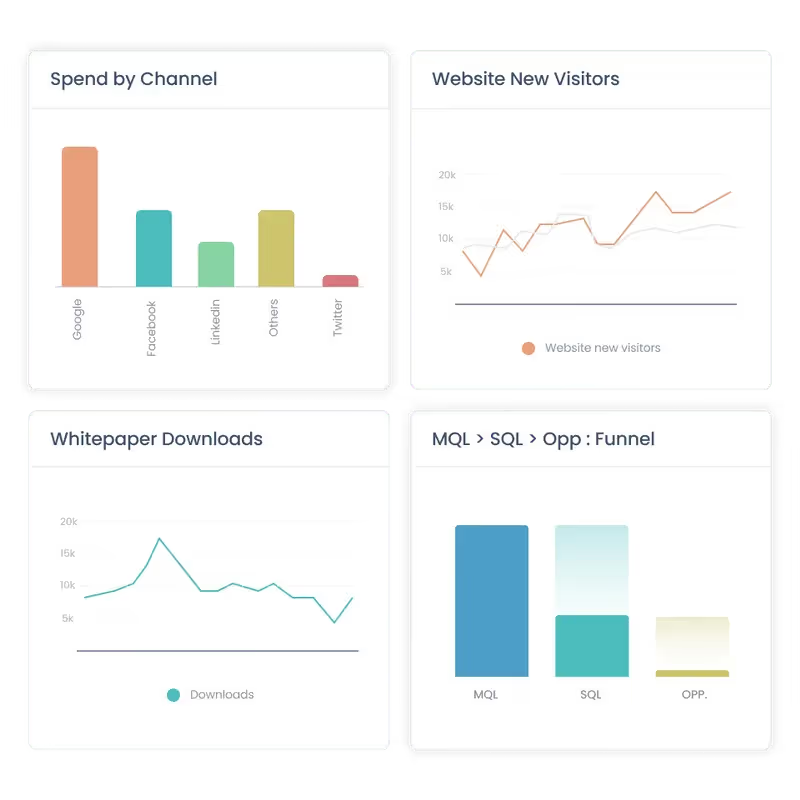
#2 Multi-touch attribution
Attribution analysis is at the core of Dreamdata and Hockeystack. Unsurprisingly, both solutions do a good job of measuring performance across marketing activities and attributing each touchpoint back to revenue.
They can stitch and credit measurable touchpoints across channels, campaigns, website, and offline events (from CRM) based on their influence on pipeline. Using a range of multi-touch attribution models, marketing teams can quantify their impact on revenue from first-touch to deal won at an account level. Here are a few use-cases multi-touch attribution on Dreamdata and Hockeystack can solve for:
- Measuring ROAS across ad campaigns
- Attributing revenue back to marketing channels
- Tracking the impact of organic social and SEO efforts
- Learning which content and channels drive bottom-line metrics

#3 Journeys
Journeys analytics is a relatively recent feature that’s not as common amongst other marketing analytics and attribution tools. That being said, both Dreamdata and HockeyStack offer variants of journey analytics.
In short, journey analytics helps teams visualize complex, non-linear customer journeys by mapping each stakeholder’s touch-points at an account level. Why is this helpful? It provides an intuitive timeline of profiles, behavior, and intent across each account within the pipeline. This information may in turn be used to personalize further marketing efforts, optimize retargeting campaigns, customize sales pitches, and identify buying patterns.

HockeyStack and Dreamdata work well for all three features covered above. Still, both tools have their own strengths and limitations. The following section highlights stand-out reasons why users may prefer one over the other.
What Dreamdata Does Better
1. Out-of-the-box Integrations
Dreamdata offers a wider range of out-of-the-box integrations as compared to HockeyStack. While both solutions provide integrations with the most popular ad platforms, CRMs, MAPs, and CDPs, Dreamdata goes the extra mile to cater to relatively niche platforms and data warehouses as well.
Key integrations supported by Dreamdata and HockeyStack*: HubSpot, SalesForce, Google Ads, Facebook Ads, Linkedin Ads, Marketo, Pardot, Intercom, Segment
Key integrations supported by Dreamdata but not HockeyStack*: Zoho, G2, Zapier, Outreach, AdRoll, Google Data Studio, BigQuery
*based on HockeyStack website
Pro Tip: Note that in case Dreamdata and HockeyStack doesn’t support an integration for a specific platform, both tools offer custom integrations as per demand.
2. Detailed & Granular Reporting
Although this isn’t necessarily a drawback with HockeyStack, users have complained about its lack of granularity. Reviews compare HockeyStack’s reporting capabilities to that of Google Analytics (GA4) — decent, but not detailed enough. Given that Dreamdata is a relatively mature product, their reporting capabilities provide deeper insights across conversion rates, customer lifetime value, and revenue attribution, and more.

3. Customer Success
B2B analytics and attributions platforms are complex. While tools are becoming increasingly intuitive, it’s important for non-technical users to have easy access to timely, effective CSM. Fortunately, Dreamdata seems to support robust customer success servicing. This is especially valuable since Dreamdata’s implementation is reportedly an involved process.

4. Templatized Reporting + UI
This is a double edged sword. Dreamdata delivers a structured, non-customizable dashboard and event framework that offers little room for flexibility. Dashboards are broadly grouped into the following categories: Engagement, Content, Performance, Journeys and Revenue.
On one hand, this may be beneficial to smaller SaaS teams with limited technical resources as it’s likely to cater to most of their analytics and reporting needs.
However, as the business starts to scale, its requirements may include custom dashboards and events that are company-specific. At this point, Dreamdata’s templatized reporting may be a drawback.
Although reviews suggest that Dreamdata involves a steep learning curve, it’s fair to assume that its UI is a step ahead of HockeyStack. HockeyStack is a relatively younger product and users tend to find the platform a little rough around the edges. That being said, reviews also suggest that they’re showing quick improvement. It’s likely only a matter of time before both platforms are on par with each other.

What HockeyStack Does Better
1. Implementation
HockeyStack makes strong claims about its rapid implementation process, suggesting that users can onboard and get started in a matter of minutes. This is in stark contrast to Dreamdata, which, as a more sophisticated tool, requires an involved, drawn-out implementation process. HockeyStack’s intuitive onboarding is a big advantage to smaller teams that don’t have the resources for dedicated onboarding or maintenance support.

2. Custom Dashboards
Dreamdata’s platform focuses on solving the most common SaaS use-cases. As a result, the platform tends to be relatively less flexible. HockeyStack, on the other hand, promotes far more customizations across events, reports, dashboards, and visualizations. HockeyStack provides the option of preconfigured templates, but lets users build reports from scratch as well. While granularity may be lacking when compared to Dreamdata, this ability for flexible dashboarding may be helpful for teams looking for tailor-made, high-level reports.

3. Funnels, Surveys & Impression Tracking
Along with the key analytics and attribution features discussed, HockeyStack provides a few features that Dreamdata doesn't.
The most valuable of these features is probably Funnels. Funnels is a powerful analytics technique that helps users graphically visualize different stages of the sales cycle. These stages can be configured by users to, for example, see how website visitors are progressing from the home page, to the pricing page, and to a blog before scheduling a demo.
Surveys is another feature that, as the name suggests, allows users to create surveys for self attribution. Finally, Linkedin Impression Tracking is another nifty feature that enables users to identify companies viewing Linkedin campaigns.
Dreamdata vs. HockeyStack: Pricing
[December 2023 Update]: Both HockeyStack and Dreamdata have revised pricing since this article was published. While HockeyStack have increased their starting price, Dreamdata have decreased theirs. Here's an updated rundown of pricing:
- Dreamdata pricing now starts at $599/mo for up to 30,000 MTUs
- HockeyStack pricing now starts at $1399/mo for up to 10,000 monthly visitors


[Pricing as of February 2023]
- Dreamdata’s paid plans start at $999/month for 10 seats and up to 10,000 MTUs
- HockeyStack’s paid plans start at $949/month for 10 seats and up to 10,000 monthly visitors
- HockeyStack offers a 14-day free trial
- Dreamdata offers a free web analytics tool as an alternative to Google Analytics


Still On The Fence About What B2B Attribution Tool To Go With?
And there you have it. A breakdown of Dreamdata and HockeyStack, and the reasons why one could be a better fit for you over the other. Still On The Fence About What B2B Attribution Tool To Go With? Here are a few reasons why you might want to consider Factors as well:
- Rapid, no-code integrations across ad platforms, CRM, MAP, and more
- Granular, end-to-end analytics, attribution, and journeys across ad campaigns, website content, offline events, organic content, and more
- Fully customizable events, properties, dimensions, and dashboard
- Dedicated customer success management
- Funnels, path analysis and website tracking
And…
- Website visitor identification
- AI-fueled conversion insights
- Real-time Slack alerts
- Cost-effective analytics pricing plans starting at $399/month

Amplitude Vs. Factors.ai: What’s The Right Choice In 2025
Amplitude Vs. Factors.ai: What’s The Right Tool For You In 2025
B2B go-to-market teams are increasingly relying on marketing and website analytics tools to track and optimize performance. In response to this growing demand, established product analytics tools like Amplitude and Mixpanel are attempting to introduce their own versions of website analytics, marketing funnels, and multi-touch attribution.
There’s no doubt that Amplitude is great at what it does. In fact, it’s rated as one of best product analytics solutions in the market today. But how does a tool that specializes in product analytics fare against a purpose-built marketing analytics solution like Factors.ai? And more importantly, what’s the better choice for your use-case?
This blog compares Amplitude vs Factors.ai. Here’s what we’ll be covering:
- Marketing Analytics vs Product Analytics
- Comparing Common Features
- What Amplitude Does, That Factors Doesn’t
- What Factors Does, That Amplitude Doesn't
- What’s The Right Tool For You?
- Comparison Table
tl;dr:

Marketing Analytics vs Product Analytics
Before diving into the comparison between Amplitude and Factors.ai, it’s worth highlighting the difference between marketing analytics and product analytics.
Marketing analytics tools are geared towards tracking and optimizing performance across campaigns, website, and CRM. Popular marketing analytics tools you may have heard of include Google Analytics, Factors.ai, and Adobe Analytics. Marketing analytics can help answer questions such as:
- Which marketing efforts drive the most ROI and pipeline?
- Which campaigns should be scaled or cut to optimize budgets?
- What marketing channels attract high-quality accounts to the website?
- How are visitors engaging with the website? What’s helping and hurting conversions?
- What is the impact of content on pipeline? Which blogs resonate most with visitors?
Product analytics tools like Amplitude, Mixpanel, and Heap are better suited to tracking event-based data within web and mobile products. These tools help understand how customers use specific features within a product. Product analytics can help answer questions like:
- Which product features are most popular? How does usage vary by customer type?
- How long do customers spend using a specific feature every week?
- Which customers are most likely to convert to higher tier plans?
- Which customers are most likely to churn based on engagement?
- How can the product road map be finetuned based on product usage?
Needless to say, marketing analytics tools are better suited to marketing & sales teams while product analytics tools are more helpful to product teams. Here’s a quick brief about Amplitude and Factors.
About Amplitude
Amplitude is an established product analytics platform that works with commercial and enterprise-level companies like Atlassian, Dropbox, and Adidas. The platform is divided into three products:
- Amplitude Analytics
- Amplitude Experiment
- Amplitude CDP.
About Factors
Factors is an AI-fueled marketing analytics and attribution platform that works with SME and mid-market B2B companies like Razorpay, Chargebee and Clickhouse. The platform is divided into 4 broad categories:
- Marketing and website analytics
- Marketing attribution
- Journeys analytics
- Visitor identification.
As Amplitude begins to dip its toes into website analytics, it makes sense to compare the two solutions. Here's a breakdown of thei common features:
Amplitude vs Factors.ai: Comparing Common Features
1. Website Analytics
As discussed, Amplitude is primarily a product analytics platform while Factors.ai specializes in marketing and web analytics. However, since both solutions rely on event-based analytics, a comparison makes sense.

1. Data
On paper, Amplitude offers a wider range of integrations than Factors. That being said, most of these integrations are geared towards product analytics use-cases.
As a result, Amplitude’s integration with ad platforms (Google, Linkedin, etc) and CRMs (HubSpot, SalesForce, etc) tends to be limited. In turn, Amplitude’s functionality as a website analytics platform comes into question.
For instance, Amplitude cannot stitch website data with CRM data such as lead stages (MQLs, SQLs, etc), offline events (sales calls, emails, etc), or revenue figures (deal size, LCV, etc). Instead, Amplitude users are limited to website analytics that’s in isolation to the rest of the buyer journey. As B2B marketing teams become increasingly responsible for driving bottom line metrics, siloed website data is a serious limitation.
Factors integrates with ad platforms, CRMs, and CDPs. As a result, it’s capable of linking website touchpoints, campaign data, and CRM events for holistic analytics and reporting.
2. Metrics & KPIs
Businesses rely on a wide range of metrics to measure website performance and guide the decision-making process. Standard metrics like bounce rates and monthly visitors are available on both Factors and Amplitude. However, granular metrics like scroll depth or engagement rates become tedious to configure on the latter.
Given that Factors.ai is designed for B2B website analytics, it offers the ability to track a wide range of KPIs and metrics out-of-the-box. Furthermore, creating custom KPIs is easier on Factors, involving zero developer dependency.

Overall, both Amplitude and Factors do a good job of basic website analytics and reporting. But if you’re really trying to identify visitor behavior, track top-performing content, and drive BoFu conversions — Factors is probably the better choice.
2. Funnels
In short, a funnel is a sequence of steps taken by users across campaigns, website, CRM, and product. Here’s a funnel of prospects visiting the pricing page, submitting a demo form, qualifying as an SQL, creating an opportunity, and closing the deal:
Even before trying its hand at marketing and website analytics, Amplitude delivered powerful funnels for product analytics. With Amplitude, product teams can learn how to improve onboarding, see how customers progress from free plans to paid ones & more.
Amplitude is now offering a similar, event-based funnel feature for websites. At the moment, Amplitude provides more room for funnel configurations and breakdowns as compared to Factors.
Factors is on par with Amplitude for most B2B funnel use-cases. That being said, Amplitude offers a few advanced functionalities that Factors doesn’t. For example only Amplitude can exclude specific events between funnel steps and compare multiple events at a single step.

Note that while Amplitude’s funnel capability is more flushed out than Factors, it is unable to bring in CRM data. As a result, Amplitude cannot create funnels across website and CRM events.
For instance, Amplitude and Factors can create the following funnel:
Homepage -> Pricing page -> Features page -> Newsletter signup -> Demo request
But only Factors can create a funnel to visualize this journey:
Homepage -> Demo request -> Opportunity created -> Deal created -> Deal won

Amplitude’s funnel is mature and better suited to product teams. Factors’ funnel showcases the wider picture and is better suited to GTM teams.
3. Path Analysis
In short, path analysis or Pathfinder helps track aggregated customer flows across website and product. It helps map out events fired by users as well as the sequence of those events taken by users within a specific time period.

Pathfinder is a core feature in Amplitude. As a result, it's currently better than Factors’ path analysis in terms of refinement and functionality. Given that path analysis is a recent feature on Factors, it’s a matter of time before both tools are on par with each other.
4. Marketing Attribution
In short, B2B marketing attribution is an analytics technique that measures the influence of various marketing touchpoints on desired conversion goals such as demos, pipeline, and revenue using a range of multi-touch attribution models.
While Amplitude is a well-established brand in product analytics, it’s only just entering the marketing attribution space. Unlike Amplitude, marketing attribution has always been a cornerstone feature for Factors.ai. Given that this is Factors’ expertise, it outperforms Amplitude comprehensively when it comes to marketing attribution.
Here are a few limitations with Amplitude’s marketing attribution that Factors solves for:
- Limited conversion milestones: As previously discussed, Amplitude cannot integrate with CRM data for marketing attribution. As a result, conversion milestones are limited to website events such as page views or form submissions. It is not possible to attribute marketing’s influence on key metrics like SQLs, pipeline, or deals using Amplitude. This makes for highly ineffective attribution for B2B marketing teams that are looking to prove their impact on revenue.
- No revenue attribution: Continuing with the previous point, Amplitude cannot attribute marketing touchpoints to revenue/spend metrics like ad spends, deals closed, deal size, etc. Given that a major use-case for B2B marketers is to measure ROI and improve resource allocation, this limitation hinders Amplitude’s attribution functionality in B2B settings.
- No account-level attribution: Amplitude’s attribution is at a user-level as opposed to at an account-level. Unlike B2C transactions, B2B deals involve lengthy sales cycles and several stakeholders from a single buying account. Naturally, it makes sense to attribute marketing touch-points at an account level rather than by individual users. Since Amplitude does not support account-level analytics, its attribution tool remains largely ineffective for B2B teams.
- Limited granularity: At the moment, Amplitude can attribute marketing channels and campaigns to website events. No doubt, having high level data at a channel and campaign level is helpful. However, in order to really optimize marketing ROI and scale the right efforts, it’s essential to have granular attribution at an ad group and keyword level as well. Currently, this is not supported by Amplitude.
- Limited touchpoints: Currently, Amplitude’s attribution modeling only considers paid ads and digital marketing touchpoints. Factors has the ability to attribute conversions to offline touchpoints such as events, webinars, and sales calls. This is a crucial piece of the puzzle for B2B marketers.

Factors counters each of these limitations by delivering multi-touch attribution across keywords, ad groups, campaigns, channels, website, and CRM events at an account-level. All in all, Factors is the better choice when it comes to B2B marketing attribution.

So what’s the right tool for you? The answer depends on what you’re looking for. To break it down further, here are a few pointers on what each platform does that the other doesn’t.
What Amplitude Does, That Factors Doesn't
- Product analytics: As discussed at the top of the article, Amplitude is a leading product analytics tool with exceptional retention analytics and cohort analytics. If these use-cases are important to you, look no further than Amplitude.
- Mobile analytics: Amplitude is capable of tracking event-level data on mobile (app-based) products as well. Since Factors focuses on web-based event analytics, it cannot analyze mobile events whatsoever.
- Experiments (A/B testing): Amplitude offers Amplitude Experiments to conduct A/B testing within the product and website. This is a valuable feature for product and design teams to test hypotheses on messaging, product features, and design.
- CDP: Amplitude provides a native customer data platform. The CDP helps improve data quality, identify new audiences, and connect behavioral data. At the moment, Factors can integrate with third-party CDPs like Segment for similar use-cases.

What Factors Does, That Amplitude Doesn’t
- Integrates marketing, CRM, and revenue data: This point has been discussed multiple times in this blog but it’s worth highlighting again. Unlike Amplitude, Factors can easily integrate data across ad campaigns, website, and CRM. This empowers holistic marketing analytics, funnels, and attribution rather than siloed web and product analytics.
- Intuitive UI & low-lift implementation: Any analytics tool involves a learning curve. That being said, Factors is significantly easier to implement and use as compared to Amplitude. Onboarding takes minutes as opposed to weeks or months. The platform is far more user-friendly for non-technical GTM teams to create relevant reports and dashboards.
- Anonymous visitor identification (IP-lookup): A stand-out feature offered by Factors.ai is anonymous visitor identification. In short, Factors uses reverse IP-lookup technology to identify companies visiting your website without requiring the visitor to submit contact information. This is especially valuable to B2B companies looking to identify, track, and convert high-intent accounts that are already visiting the site.
- Automated AI-fueled insights: Factors’ AI-algorithm works to provide intuitive automated insights into what’s helping and hurting custom conversion goals. With Explain and Weekly Insights, teams can drill down into how keywords, campaigns, channels, website content, and offline events are influencing objectives such as increasing traffic, booking demos, ramping up newsletter subscriptions, or driving pipeline.


So What’s the Right Tool For You?
This is the primary consideration when deciding between Amplitude and Factors — are you looking to monitor and improve your product? If so, Amplitude is the better choice. Are you a B2B team looking to monitor and optimize GTM performance? If so, Factors probably makes more sense.
In summary...

Still on the fence about which tool may be better suited to you? See Factors in action over a quick demo
Compare Factors.ai with other tools:

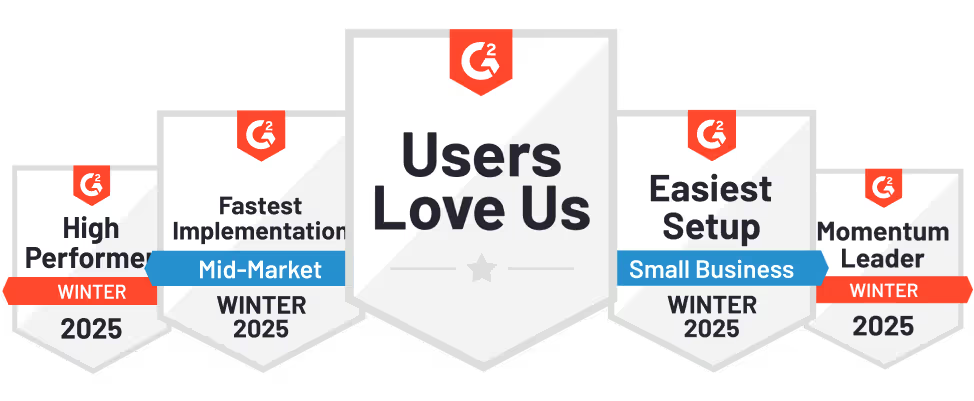
.svg)
